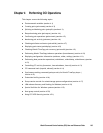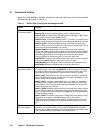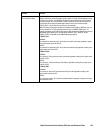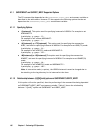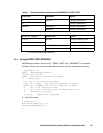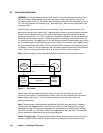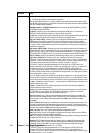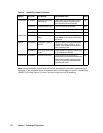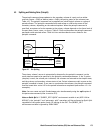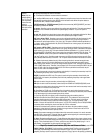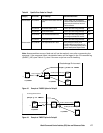
170 Chapter 4 Performing CCI Operations
Parameter Value
Options -h: Displays Help/Usage and version information.
-q: Terminates the interactive mode and exits the command.
-z or -zx (OpenVMS cannot use the -zx option): Makes the paircreate command enter interactive mode.
The -zx option guards performing of the HORCM in interactive mode. When this option detects a HORCM
shut down, interactive mode terminates.
-I[H][M][instance#] or -I[TC][SI][instance#] Specifies the command as [HORC]/[HOMRCF], and used
for specifying Instance# of HORCM
-g <group>: Specifies a group name defined in the configuration definition file. The command is
executed for the specified group unless the -d <pair Vol> option is specified.
-d <pair Vol>: Specifies paired logical volume name defined in the configuration definition file. When this
option is specified, the command is executed for the specified paired logical volume.
-d[g] <raw_device> [MU#]: Searches a group on the configuration definition file (local instance) for the
specified raw_device, and if the specified raw_device is contained in the group, the target volume is
executed as the paired logical volume (-d) or group (-dg). This option is effective without specification of
“-g <group>“ option. If the specified the raw_device is contained in two or more groups, the command is
executed on the first group.
-d[g] <seq#> <LDEV#> [MU#]: Searches a group on the configuration definition file (local instance) for
the specified LDEV, and if the specified LDEV is in the group, the target volume is executed as the paired
logical volume (-d) or group (-dg). This option is effective without specification of “-g <group>“ option. If
the specified LDEV is contained in two or more groups, the command is executed on the first group. The
<seq #> <LDEV #> values can be specified in hexadecimal (by addition of “0x “) or decimal notation.
-f[g] <fence> [CTGID] (Hitachi TrueCopy or UR only): Specifies the fence level for assuring the
consistency of paired volume data. A fence level of “data”, “status”, “never”, or “async” must be specified.
Fence level "-f async" can be specified only for TC Async/UR. The “-fg” option is used to make TC Sync
CTG volume, and fence level must be specified as "-fg data", "-fg status", or "-fg never".
A CTGID (CT Group ID) is assigned automatically if you do not specify the “CTGID” option in this
command (and define it in the config file). If “CTGID” is not specified (with “-f async” or “-fg” option) and
the maximum number of CT groups already exists (e.g., 256 for USP/NSC, 128 for 9900V), an
EX_ENOCTG error will be returned. Therefore, the “CTGID” option can forcibly assign a volume group to
an existing CTGID (0-15/63/127/255) on the Hitachi RAID storage systems. The CTGID option is ignored
unless you specify the “-f async” or “-fg” option.
-vl or -vr: Specifies the data flow direction and must always be specified. The -vl option specifies “local”
and the host which issues the command possesses the primary volume. The -vr option specifies “remote”
and the remote host possesses the primary volume while the local host possesses the secondary volume.
-c <size>: Specifies the number of extents (1 - 15) to be used for the initial data copy. If this option is not
specified a default value is used.
-nocopy: Creates paired volumes without copying data in the case in which the data consistency of
simplex volumes is assured by the user.
-nomsg: Suppresses messages to be displayed when this command is executed. It is used to execute
this command from a user program. This option must be specified at the beginning of a command
argument. The command execution log is not affected by this option.
-split (ShadowImage only): Splits the paired volume after the initial copy operation is complete. This
option will return after changed the state in PVOL_PSUS & SVOL_COPY immediately, and SVOL state
will be changed to “SVOL_SSUS” after all data is copied. (See Note 2 under
Table 2.3 for details.)
-m <mode>:
mode = n
oread (ShadowImage only): Specifies the noread mode for hiding the secondary volume. The
secondary volume becomes read-disabled when this mode option is specified. The secondary volume is
read-enabled when this mode option is omitted. Note: The primary volume becomes read-disabled during
a reverse resync operation (restore option of pairresync command).
mode = cyl (9900V only): sets TrueCopy bitmap difference management to cylinder.
mode = trk (9900V only): sets TrueCopy bitmap difference management to track.
Note: If the mode (cyl or track) is not specified, the default values are used: default is track for OPEN-3
and OPEN-9; default is cylinder for OPEN-E and OPEN-L.
Note: For TrueCopy volumes paired between 9900V and 9900 storage systems, the bitmap tables will be
managed at the Cylinder level, even if Track is specified.
mode=grp [CTGID] (9900V ShadowImage only). Makes a group for splitting all ShadowImage pairs
specified in a group. Like a TrueCopy Async/UR consistency group, ShadowImage guarantees data
consistency among multiple LUNs in a group at a single point in time when doing a split using the
“pairsplit -g <group>“ command (except “-S” or “-E” option).
A CTGID (CT Group ID) is assigned automatically if you do not specify the “CTGID” option in this
command. If “CTGID” is not specified and the maximum number of CT groups already exists, an
EX_ENOCTG error will be returned. Therefore, the “CTGID” option can forcibly assign a volume group to
an existing CTGID (e g 0
127 on 9900V)




